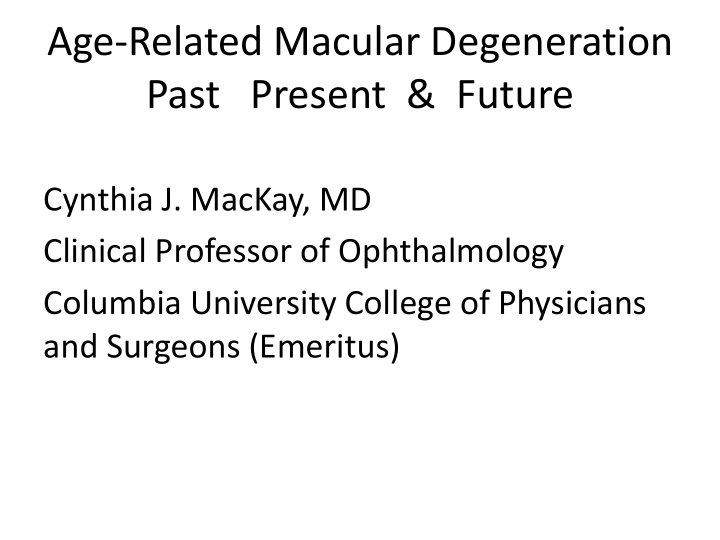



Age-Related Macular Degeneration Past Present & Future Cynthia J. MacKay, MD Clinical Professor of Ophthalmology Columbia University College of Physicians and Surgeons (Emeritus)
Age-related Macular Degeneration (AMD) 1 AMD is #1 cause of blindness over 65 2 My risk - 1/3 over 65 3 What are the symptoms 4 Two types: dry (95%) wet (5% 95% of blindness) 5 What causes AMD 6 Present treatment 7 Possible treatment in the future 8 How to decrease your risk
AMD: SYMPTOMS 1 Loss of detail: reading driving faces 2 Need for more light 3 Difficulty adapting to light/dark 4 Blank spots 5 Decreased color vision – esp. blues 6 Distortion (See ophthalmologist that day)
Normal Fundus (Back of Eye)
Normal Retina Dry Age-Related Macular Degeneration: Drusen & RPE Atrophy
A gene for Age-Related Macular Degeneration has been identified* on chromosome one (2005) This may allow for targeted treatment The gene codes for complement factor H *Josephine Hoh at Yale School of Medicine, and colleagues from Yale, Rockefeller University and the National Eye Institute.
Dry Macular Degeneration What to avoid Ocuvite/Preservision “Stem Cell Tourism”
THE FUTURE 1 Complement inhibition: disappointing except for Complement factor I (“gene testing will tailor therapy”) 2 Gene therapy with adenovirus vector: two phase-2 trials of anti-VEGF for wet AMD 3 Long-acting pellets for wet AMD 4 Ongoing trial: high dose (80 mg) Lipitor 5 Reconstruction of RPE by transplant: Gouras, fetal RPE; NEI, 1/16/16, blood cell converted to RPE cell
RPE Transplant Technique
Transforming Blood Cell into RPE Cell
DECREASING YOUR RISK OF AMD 1 Don’t smoke (3 -5 times the risk) 2 Diet: vegetables; limit saturated fat 3 Control your weight and blood pressure 4 Check your eyesight daily 5 See your ophthalmologist yearly
Recommend
More recommend